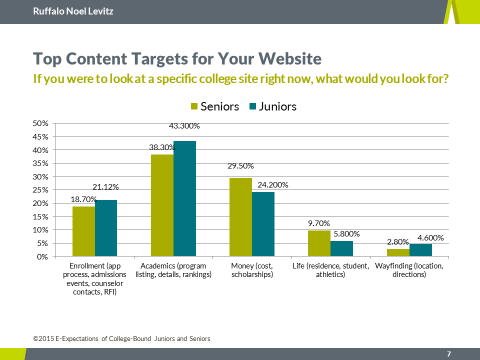enrollment
How to grab more web traffic with successful university and college SEO content strategies
When looking at the opportunity to drive more traffic to a university or college website, content strategy plays a critical role. In my work with campus websites, I’ve noticed a very critical part of SEO content strategy that is overlooked is identifying new content opportunities.
How do you identify new content opportunities?
While there are many ways to identify gaps in content, today we will discuss university SEO keyword research. My recommendations below are based on successful academic program content, as they are the leading target resources from a user and SEO perspective.
To break your content strategy goal down in economic terms, i.e. supply and demand: do you have the supply of robust academic program pages to meet demand for content that answers prospect’s key questions? Examples would include available programs, costs, outcomes, curriculum, and experiential learning options. To identify more granular SEO opportunities you can do the following:
- Develop initial SEO content opportunity lists at a page and global thematic level, based on internal knowledge, research, and hunches
- Find an SEO tool/platform that can assist you in
- Benchmarking
- Targeting opportunities
- Identifying new topics for your content
- Uncovering competitors’ content strategies
- Prioritize content development based on a mix of content performance insights, program capacity, and program popularity among other factors
- Measure and confirm relevance and competition
- Iterate for continuous SEO growth
- Repeat
What is the ROI of great SEO-optimized academic program content?
A common question when working with SEO content strategy is, what is the payoff? How do I show the value of these efforts? As the phrase “long tail” implies, there are some dots to connect and it will take some time to get there. But in short order here are the steps to take that will demonstrate the value of SEO work:
- Optimize specific pages and the site as a whole
- Gradually climb to the top of the search engines for relevant content and questions
- Attract more traffic and increase visitor engagement
- Increase calls to action such as RFIs, visits, applications and other enrollment activities (RFIs = Request for Information forms)
- Boost enrollment (undergrad, graduate, online, etc.)
How can you measure the success of SEO for higher education?
In order to demonstrate the impact of the above mentioned search engine optimization, you will need to establish measurement metrics using your analytics tools of choice. Using your preferred platform you should be able to benchmark and measure the following:
- Search Engine Ranking Positions (SERP) for your primary keyword phrases
- Visits to your website from organic (non-paid) search traffic
- Page views
- Conversions (users taking action on your site through forms, downloads)
- Revenue based on key digital activities and conversions
Join us for a free SEO webinar
Attracting More Prospective Students Through Search Engine Optimization
Thursday, May 12, 2016
2-3 p.m. Eastern Time
Register online
At this webinar, I’ll share more details on how to increase the online visibility of your admissions pages, program pages, and other key web content for student recruitment by optimizing pages for search engine results.
Unable to attend?
Email me with any questions you have, or call me at 800.876.1117. I’ll be happy to respond and clarify any points.
